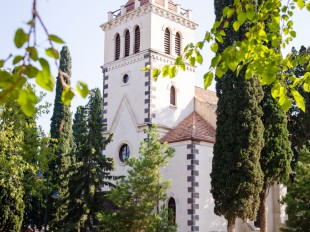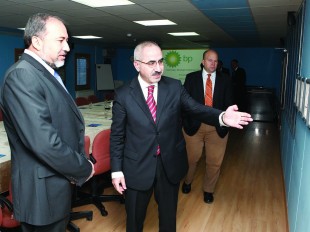On a windless autumnal evening in Baku American photojournalist Ed Kashi peers through his camera’s viewfinder into a crowd of expectant football fans. Metres away I stand carrying his bag, my back turned to a very rare and enticing spectacle – Athletico Madrid versus FK Qarabag in the Champions League. In truth, though, I’m more interested in watching Kashi, a visual storyteller and part owner of the VII photo agency, whose portfolio covers the Northern Ireland “Troubles,” the Kurdish independence struggle, Iraq and the Israeli-Palestinian conflict.
This isn’t his first visit to Azerbaijan. Four years ago Kashi was commissioned by TEAS to document the country’s IDP crisis; an estimated one million Azerbaijanis were forced to relinquish their homes during the active phase of the Karabakh conflict (1989-1994). The resulting series was called Unresolved Deams, the expansion of which is the reason for his second visit. But prior to venturing out west once again, his focus is on the football team that carries the hopes and dreams of all Azerbaijani IDPs.
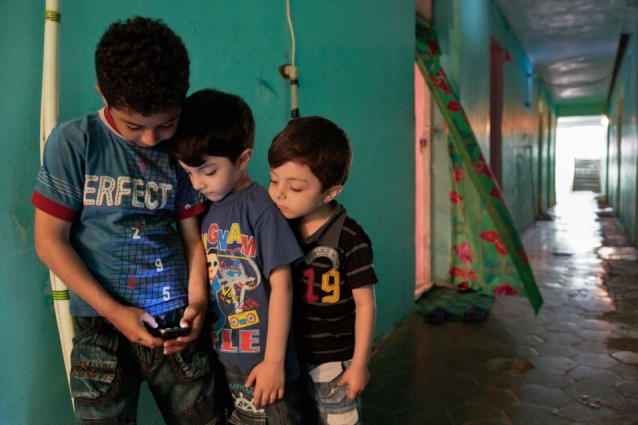 Refugees and IDPs living in the former resort complex of Qizil Qum, in the village of Pirshagi near Baku. 1 June 2013. Photo: Ed Kashi
Refugees and IDPs living in the former resort complex of Qizil Qum, in the village of Pirshagi near Baku. 1 June 2013. Photo: Ed Kashi
I’m looking for symbols, he says, honing in on the rowdiest part of the crowd, where we remain for most of the match, documenting the ebb and flow of the passionate fans.
The following morning Kashi leaves for Goranboy to meet survivors of the Khojaly Tragedy (the night of 25-26 February 1992 when the town of Khojaly was overrun by invading Armenian forces and 613 Azerbaijani civilians lost their lives). From there he travels to Jojug Marjanli, a settlement currently being rebuilt and resettled after Azerbaijani forces recaptured the nearby Lele Tepe height during The Four Day War of April 2016, the worst clashes since the 1994 ceasefire agreement.
A positive vibe
Fast forward a week and Kashi’s back in Baku, where I catch up with him again over coffee, eager to find out about his latest trip.
Four years on what’s struck him most, he says, is a new “sense of resettlement” – homes with water, electricity and other life comforts – and a general sense of “moving on” in these IDP areas. This is especially true of Jojug Marjanli, which he was one of the first (if not the first) foreign photojournalists to visit since April 2016. There, he saw the ongoing renaissance of a settlement for some 200-250 families and the two strategic heights that govern the fate of the area: the one now controlled by Azerbaijan and the other, right next to it virtually, which is still with Armenia, making the situation precarious for those returning. Instead of fear, however, what he noted was a sense of resolve:
But in Jojug Marjanli there were younger families, there’s a school there that’s only maybe a quarter full but still, you know, there’s clearly a determination and a move to resettle that place and to establish a normal town.
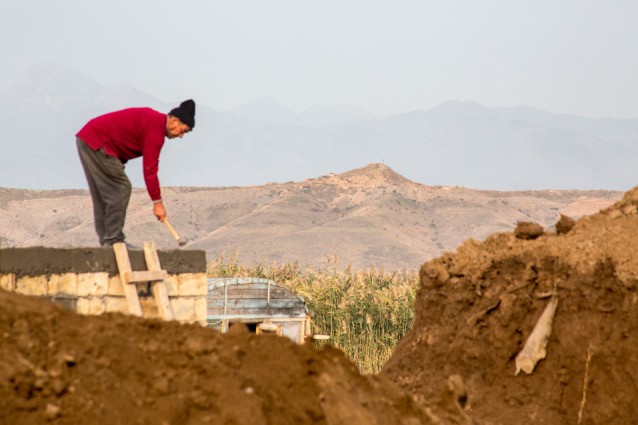 Construction work on a water pipeline with Lele Tepe, the height that Azerbaijani forces recaptured in April 2016, visible in the distance. 21 October 2017. Photo: Ed Kashi
Construction work on a water pipeline with Lele Tepe, the height that Azerbaijani forces recaptured in April 2016, visible in the distance. 21 October 2017. Photo: Ed Kashi
Kashi’s words reflect local media reports of the massive construction efforts over the last year or so – new roads, new homes, a new mosque (built to look like the iconic Yukhari Govhar Agha Mosque in Shusha), medical facility and school – in a government bid to present Jojug Marjanli as the beginning of a sort of Great Return, a gradual restoration of occupied Azerbaijani territory. Despite the village only ever falling under Armenian occupation for a few months in 1993, the enemy’s proximity had made it too dangerous (for all but one family) to live there until Azerbaijan recaptured territory in April 2016. Construction only began in March this year and has taken place in two phases, pursuant to a presidential decree signed in January 2017; for the first phase alone, which lasted just two months (from March to May), four million manats were reportedly allocated from the President’s Reserve Fund. The second phase began in June and added 100 more houses. Political significance aside, however, Kashi describes being more struck by the everyday normality:
I mean the vibe was totally positive. It’s funny, this is something I’ve become much more sensitised to, but as a journalist we often stick our noses in other people’s businesses looking for the problems and sometimes... if you went to Jojug Marjanli just as an innocent traveller, you would not think “this is some remnant of a conflict,” you would just think “this is a new housing development.”
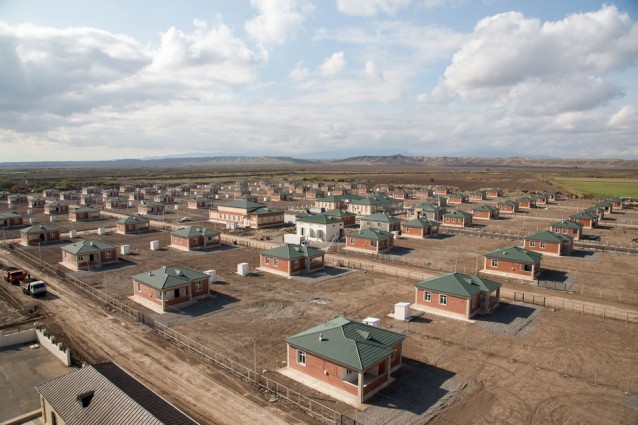 In April 2016 Azerbaijani forces recaptured the Lele Tepe height near the deserted town of Jojug Marjanli, allowing for it to be resettled and rebuilt. More than one year later here is a view of the new homes and modern town. 19 October 2017. Photo: Ed Kashi
In April 2016 Azerbaijani forces recaptured the Lele Tepe height near the deserted town of Jojug Marjanli, allowing for it to be resettled and rebuilt. More than one year later here is a view of the new homes and modern town. 19 October 2017. Photo: Ed Kashi
Resolving dreams
This good vibe, Kashi believes, is reflected in his latest set of photographs, as opposed to the clear emphasis on despair in Unresolved Dreams. To make that series, he purposely travelled to the very worst IDP settlements – where you had IDPs that were really living very marginal lives, he says – in a deliberate attempt to make the most dramatic images that might engender global sympathy towards Azerbaijan’s IDP crisis.
But four years later, as Kashi believes, many of those settlements no longer exist and his latest series, he feels, will allude to progress, hope and resolve, such as the young maths teacher he met who “was just positive” and not dwelling on the trauma of the past. It seemed to him as though people are finally moving on and that the government’s investment in rebuilding at least some of their lives is beginning to pay off.
Having experienced conflict zones around the globe, he knows very well the value of creating opportunities for IDPs rather than keeping them marginalised, thereby letting them (especially young men) turn to bad things, a scenario he witnessed in the case of the Israeli-Palestinian conflict:
I would prefer to see a two-track approach where you help people establish lives that are more whole and more healthy because that’s good for the overall society, but then you continue to prosecute, hopefully only on a political level, the political solution.
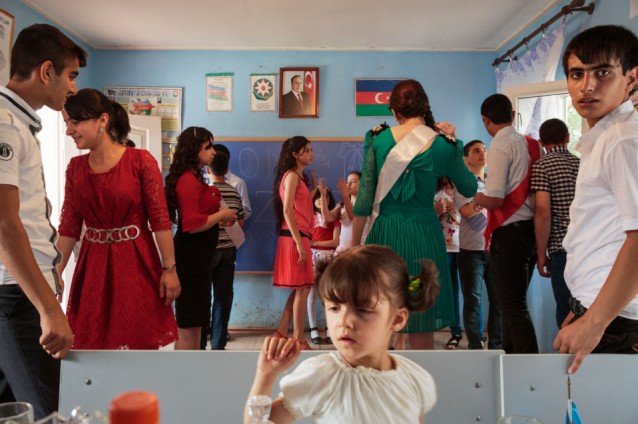 Children celebrating their last day of school in the village of Shirvanli, near the town of Aghdam. 31 May 2013. Photo: Ed Kashi
Children celebrating their last day of school in the village of Shirvanli, near the town of Aghdam. 31 May 2013. Photo: Ed Kashi
The media’s gaze
Unresolved Dreams offers a window into daily life in IDP and refugee settlements in Aghdam and Aghjabedi. The images reveal makeshift housing, vacant stares and the children growing up with this as their normality. It’s been exhibited in London, Paris, Berlin and Brussels, yet Kashi admits that he doesn’t really know the impact it’s had. Having struggled to publish the project through his normal channels, all he can say for sure is that the Karabakh issue is still off the international media’s radar. He’s always interested in why certain issues resonate more than others; in the case of Karabakh, we surmise, it must simply be a case of not directly impacting Western lives enough:
Even last April, when the Four Day War happened, if I hadn’t had some connection to this story from my previous visit to the region, I would not have noticed or paid attention to the small mention of it on page 30 in the New York Times [...] it’s always tricky to understand what controls the media’s gaze and who will notice what stories. Furthermore, in this time of hyper partisanship in both politics and the media, where the internet actually causes greater misunderstanding and is a source of damaging misinformation, important local stories like this one can get lost in the ether.
Never more so than now at what Kashi calls a confusing time, in light of the many changes sweeping the globe such as the support for far right politicians and, above all, recent developments in his own backyard:
There’s sort of like this weird political shift that is going on and for me most profoundly with Trump being elected and the way he’s conducting business, it just feels so confusing. Well it’s not confusing, it’s dead wrong to me but what’s confusing is this, that there’s not more condemnation [...]
It’s a time that feels like the world is not spinning quite right on its axis, he concludes.
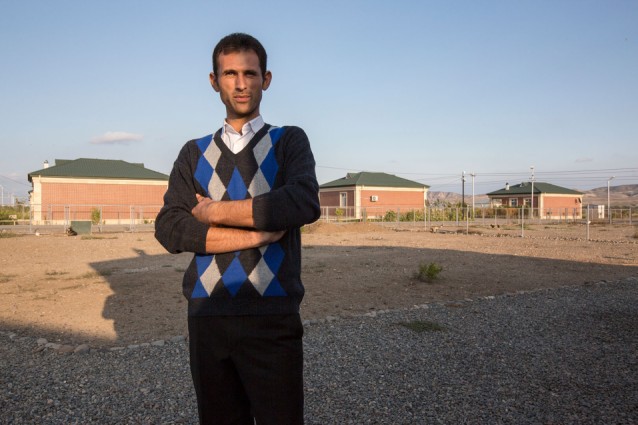 Ilkin Tabrizli, 27, a teacher in the local primary school in the newly rebuilt and resettled town of Jojug Marjanli. 19 October 2017. Photo: Ed Kashi
Ilkin Tabrizli, 27, a teacher in the local primary school in the newly rebuilt and resettled town of Jojug Marjanli. 19 October 2017. Photo: Ed Kashi
A new approach
So what does this mean for visual journalism? Kashi says it’s forcing him to change his approach. Whereas 10 to 15 years ago he might pitch a broad story on, for example, the Pakistani Punjab, he’s now having to “retract” his ambitions: magazines have reduced their budgets and there’s no longer the demand for those sorts of sweeping stories. His current project examining chronic kidney disease among rural workers around the world is a great example: it’s clearly defined and Kashi feels he’s found his niche: I own that issue in my own little world, he says. For this, he enjoys working as part of a larger team – of researchers, activists and epidemiologists – and feels that this sort of advocacy work enables him to maximise his impact.
Together with his wife, the filmmaker Julie Winokur, and Rutgers University Newark, he’s also developing a pioneering multimedia project called Newest Americans, which sheds light on immigration in the United States, a super important issue, he says with great enthusiasm. He adds: I’m past the phase of making a name for myself, now it’s about – how can I use the time I have left to actually have a positive impact?
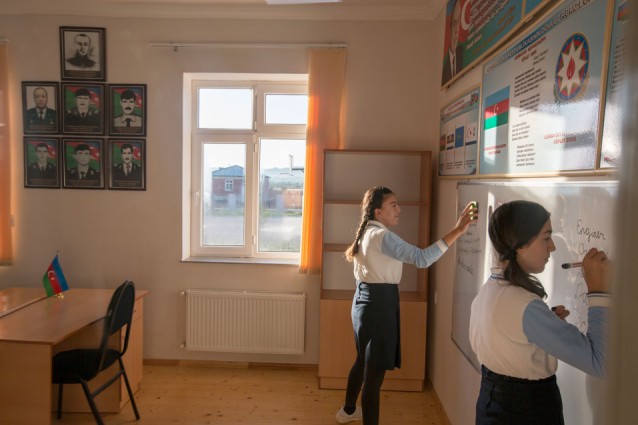 More than one year after Azerbaijani forces recaptured the Lele Tepe height, kids are going to school in the modern,newly rebuilt town of Jojug Marjanli. 20 October 2017. Photo: Ed Kashi
More than one year after Azerbaijani forces recaptured the Lele Tepe height, kids are going to school in the modern,newly rebuilt town of Jojug Marjanli. 20 October 2017. Photo: Ed Kashi

